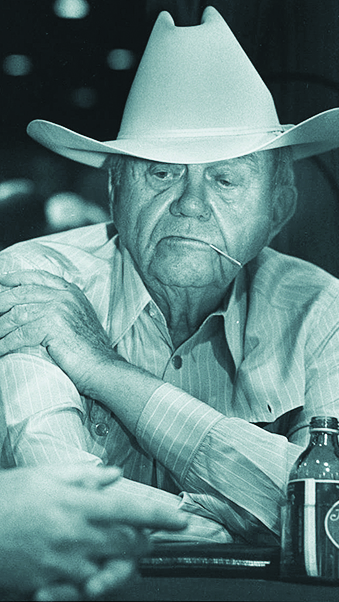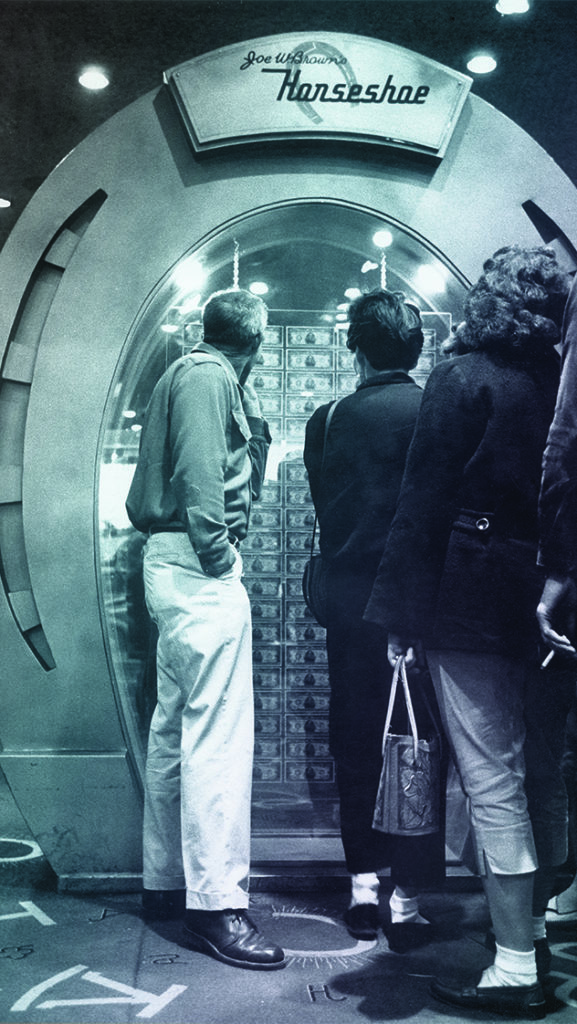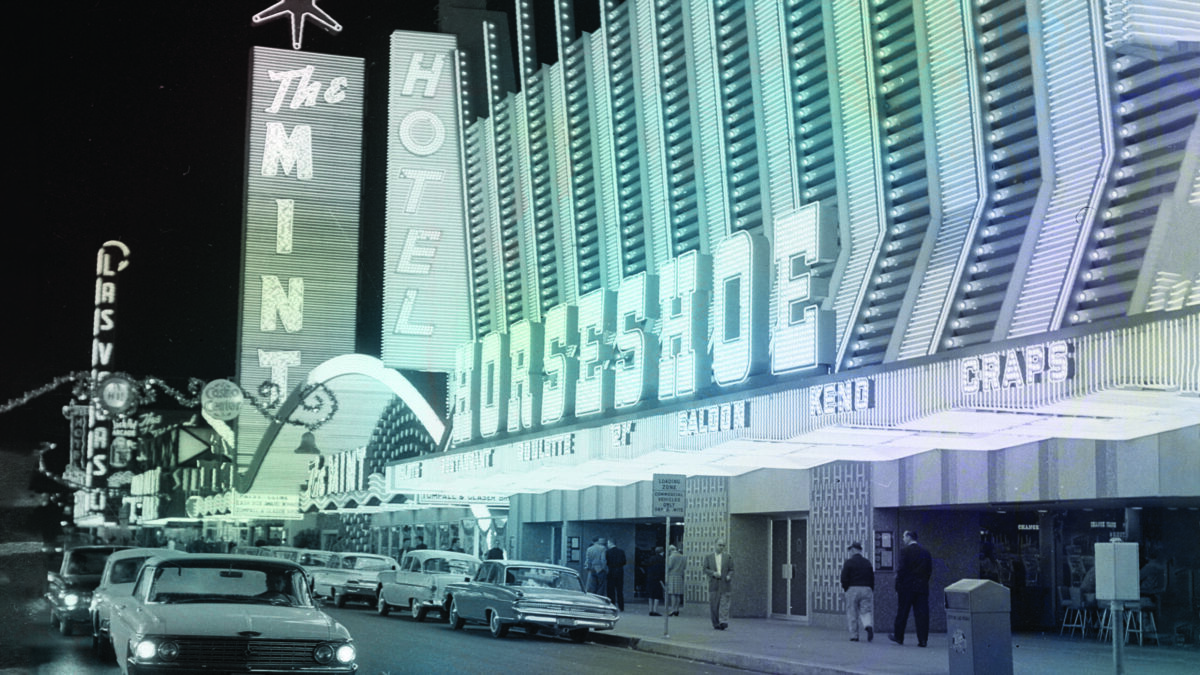When Benny Binion ran a gambling racket in Dallas during the Depression, he discovered that an employee was stealing from him. To address the matter, he stabbed the transgressor in the eye with a pencil.

Upon learning that some fool had organized a rival racket, Binion shot the interloper dead on a crowded street in broad daylight. In those days, Benny Binion never dreamed that half a century later, 18,000 people would celebrate his birthday by chanting his name, or that the mayor of a major American city would dedicate an equestrian statue of him. On the other hand, the metropolis of Binion’s future was Las Vegas, Nevada, and Benny, now a charming millionaire who owned a famous casino there, had invented the World Series of Poker.
“No one,” wrote biographer Doug J. Swanson, “went from murderous street thug to domineering crime boss to revered businessman to civic treasure like Benny Binion.”
Born in Pilot Grove, Texas, in 1904, Lester Ben Binion quit school after second grade to wander Texas with his father, a horse trader. The family business of buying nags in one place and selling them in another was steeped in chicanery designed to hide the four-footed merchandise’s defects. On the road Benny learned two valuable skills—how to cheat, and how to avoid being cheated. “There’s more than one kind of education,” he said decades later, “and maybe I prefer the one I got.”
During Prohibition, he smuggled booze from Mexico into El Paso. After getting arrested, he moved to Dallas and became a middleman, buying hooch from rural moonshiners and selling it to speakeasies in town. Soon, he had expanded into gambling, organizing an illegal numbers lottery in a legendarily raffish Black neighborhood, Deep Ellum. He began running dice games in a dozen Dallas hotels. He bought a piece of the legendary Top O’Hill Terrace, a high-end casino and whorehouse in nearby Arlington.
Binion got rich, and he shared his wealth with cops, prosecutors, and politicians. Strategic generosity helped when he was arrested, which occurred frequently. Dallas authorities picked him up for theft, for burglary, for assault—but always dropped the charges. In 1931, pleading guilty to killing a Black bootlegger, he got off with a suspended sentence. In 1936, on Allen Street, he put three slugs into a rival hustler’s heart, then surrendered to police, claiming self-defense. The district attorney declined to prosecute. Years later somebody asked if he had bribed the D.A. “Well, I don’t know,” Benny Binion said. “Maybe I had.”
By 1940, Binion was Dallas’s king of crime. “Binion’s interests,” the FBI reported, “had complete control of all rackets in the Dallas area during the war years.”
Sick of corruption, Dallas voters in 1946 chose a new sheriff, replacing Binion’s man with an eager reformer whose victory prompted Benny to flee that December. He left town by night in his Cadillac, two bodyguards riding shotgun with Thompsons and $1 million in the Caddy’s trunk. “I had to get out,” he later explained. “My sheriff got beat in the election.”
He headed for Las Vegas, a rogue’s paradise where gambling was legal and other vices were regarded with bemused tolerance. Within days of arriving, Binion was attending the star-studded opening of mobster Benjamin “Bugsy” Siegel’s Flamingo casino—“the biggest whoop-de-do I ever seen,” Benny said. Bugsy’s opulent fête marked the birth of modern Las Vegas, a city built by gangsters, and Binion became one of its founding fathers.
Fellow mobsters sported silk shirts and pinstripe suits. The unpretentious Binion wore a cowboy hat and boots and Western shirts whose buttons were gold coins. Every night he went home to eat dinner with his wife, Teddy Jane, and their five kids. Nonetheless he became a major Sin City player, obtaining millions in secret loans from Dallas bankers that he funneled to the Vegas mob—while taking a sizable slice of

every deal.
In 1951, he bought the failing Eldorado casino in downtown Vegas and renamed it the Horseshoe. Teddy Jane decorated the place—red carpeting, emerald green ceilings and steer horns on the walls—because, Benny said, “I don’t know nothing about designing nothing.” But he did know promotion. He installed a horseshoe-shaped case displaying $1 million in $10,000 bills. Tourists came to pose for pictures with the boodle, then stayed to lose at the tables. Binion’s Horseshoe was as down-home as its owner, offering cheap food and drink and no-frills wagering. “If you wanna get rich,” Benny advised, “make little people feel like big people.”
Already rich, Benny got richer and he continued his policy of greasing palms. But he skimped with the IRS and in 1953, Uncle Sam indicted him for failing to pay $862,000 in taxes. He pleaded guilty, then, trying to bamboozle the judge, played the bumpkin card: “I’m kinda ignorant,” he said, “and I got to gambling around and, well, you know.” The judge knew exactly—and gave him five years in the federal penitentiary at Leavenworth, Kansas.
Freed in 1957, Benny volunteered to inform for the FBI. J. Edgar Hoover was delighted, but Benny’s tips, probably designed to keep the Feds off his back, never paid off.
He hated lawmen so much that when Horseshoe customers broke bad, instead of calling the cops he had club-wielding guards whomp miscreants. “We used to just beat the goddam shit out of them,” Benny bragged.
In 1970, Binion introduced the hustle that made him famous. The World Series of Poker corralled legendary gamblers at the Horseshoe for a winner-take-all tourney. ABC’s Wide World of Sports covered the annual event. Soon, The New Yorker and Le Monde were profiling Benny and he was entertaining America by telling droll stories on TV talk shows.
The murderous crime boss had become a lovable old rogue. In 1987, to mark his 83rd birthday, his family rented a basketball arena and threw a party. Willie Nelson entertained 18,000 guests, who sang “Happy Birthday” and chanted “Benny! Benny! Benny!”
By then, Benny was sick. Twice, a defibrillator had to jumpstart his stopped heart. He told an interviewer that during one of those episodes he had seen Jesus. The interviewer suggested he might see Jesus again in heaven. Benny said he expected to wind up in hell. Not if you repent, the interviewer said. “That’s the problem,” Benny replied. “There’s some of it I can’t repent. I’ve tried and I just can’t.”
He died of heart failure on Christmas, 1989. His body was interred at the Chapel of Eternal Peace in Eden Vale Memorial Park in Las Vegas. The location of his soul is unknown.
This American Schemers column appeared in the October issue of American History.





